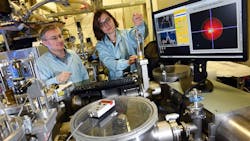Ultrafast laser pulses strike nanowires to create high-energy plasma for research
Physicists at Friedrich Schiller University in Jena, Germany have developed a new method for producing plasma using mid-IR femtosecond laser pulses and nanowires, which enables them to deal with some of the problems that stand in the way of this extremely difficult process.1
More than 99% of material in space is present as plasma; it is therefore no wonder that physicists are keen to study such material. Unfortunately, creating and studying plasmas on Earth using the high temperature and pressure that exist inside stars is extremely challenging for various reasons. Plasmas can be created using ultrafast laser pulses to ablate materials, but there are problems.
"However, [the resulting plasma] almost immediately starts to act like a mirror and reflects a large part of the incoming energy, which therefore fails to penetrate the matter fully. The longer the wavelength of the laser pulse, the more critical the problem," says Zhanna Samsonova, who played a leading role in the project.
To avoid this mirror effect, the researchers in Jena used samples made of silicon nanowires. The diameter of such wires, a few hundred nanometers, is smaller than the 3.9 μm wavelength of the incoming mid-IR light. "We were the first to use a laser with such a long wavelength for the creation of plasma," says Christian Spielmann, one of the researchers. "The light penetrates between the wires in the sample and heats them from all sides, so that for a few picoseconds, a significantly larger volume of plasma is created than if the laser is reflected. Around 70% of the energy manages to penetrate the sample." Furthermore, thanks to the short laser pulses, the heated material exists slightly longer before it expands.
"With our method, it is possible to achieve new maximum values for temperature and density in a laboratory," says Spielmann. With a temperature of around 10 million K, the plasma is far hotter than material on the surface of the Sun, for example. Spielmann also mentions the collaborative partners in the project. For the laser experiments, the Jena scientists used a facility at the Vienna University of Technology; the samples come from the National Metrology Institute of Germany in Braunschweig; and computer simulations for confirming the findings come from colleagues in Darmstadt and Düsseldorf.
Source: https://www.uni-jena.de/en/190605_Plasmaphysik.html
REFERENCE:
1. Zhanna Samsonova et al., Physical Review X, 2019, doi: 10.1103/PhysRevX.9.021029
About the Author
John Wallace
Senior Technical Editor (1998-2022)
John Wallace was with Laser Focus World for nearly 25 years, retiring in late June 2022. He obtained a bachelor's degree in mechanical engineering and physics at Rutgers University and a master's in optical engineering at the University of Rochester. Before becoming an editor, John worked as an engineer at RCA, Exxon, Eastman Kodak, and GCA Corporation.

